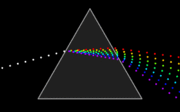Optics
2008/9 Schools Wikipedia Selection. Related subjects: Physics
Optics (ὀπτική appearance or look in Ancient Greek) is a branch of physics that describes the behaviour and properties of light and the interaction of light with matter. Optics explains optical phenomena.
The field of optics usually describes the behaviour of visible, infrared, and ultraviolet light; however because light is an electromagnetic wave, analogous phenomena occur in X-rays, microwaves, radio waves, and other forms of electromagnetic radiation. Optics can thus be regarded as a sub-field of electromagnetism. Some optical phenomena depend on the quantum nature of light relating some areas of optics to quantum mechanics. In practice, the vast majority of optical phenomena can be accounted for using the electromagnetic description of light, as described by Maxwell's Equations.
The field of optics has its own identity, societies, and conferences. The pure science aspects of the field are often called optical science or optical physics. Applied optical sciences are often called optical engineering. Applications of optical engineering related specifically to illumination systems are called illumination engineering. Each of these disciplines tends to be quite different in its applications, technical skills, focus, and professional affiliations. More recent innovations in optical engineering are often categorized as photonics or optoelectronics. The boundaries between these fields and "optics" are often unclear, and the terms are used differently in different parts of the world and in different areas of industry.
Because of the wide application of the science of "light" to real-world applications, the areas of optical science and optical engineering tend to be very cross-disciplinary. Optical science is a part of many related disciplines including electrical engineering, physics, psychology, medicine (particularly ophthalmology and optometry), and others. Additionally, the most complete description of optical behavior, as known to physics, is unnecessarily complicated for most problems, so particular simplified models are used. These limited models adequately describe subsets of optical phenomena while ignoring behaviour irrelevant and/or undetectable to the system of interest.
Classical optics
Before quantum optics became important, optics consisted mainly of the application of classical electromagnetism and its high frequency approximations to light. Classical optics divides into two main branches: geometric optics and physical optics.
Geometric optics, or ray optics, describes light propagation in terms of " rays". Rays are bent at the interface between two dissimilar media, and may be curved in a medium in which the refractive index is a function of position. The "ray" in geometric optics is an abstract object which is perpendicular to the wavefronts of the actual optical waves. Geometric optics provides rules for propagating these rays through an optical system, which indicates how the actual wavefront will propagate. Note that this is a significant simplification of optics, and fails to account for many important optical effects such as diffraction and polarization.
Geometric optics is often simplified even further by making the paraxial approximation, or "small angle approximation." The mathematical behaviour then becomes linear, allowing optical components and systems to be described by simple matrices. This leads to the techniques of Gaussian optics and paraxial raytracing, which are used to find first-order properties of optical systems, such as approximate image and object positions and magnifications. Gaussian beam propagation is an expansion of paraxial optics that provides a more accurate model of coherent radiation like laser beams. While still using the paraxial approximation, this technique partially accounts for diffraction, allowing accurate calculations of the rate at which a laser beam expands with distance, and the minimum size to which the beam can be focused. Gaussian beam propagation thus bridges the gap between geometric and physical optics.
Physical optics or wave optics builds on Huygen's principle and models the propagation of complex wavefronts through optical systems, including both the amplitude and the phase of the wave. This technique, which is usually applied numerically on a computer, can account for diffraction, interference, and polarization effects, as well as aberrations and other complex effects. Approximations are still generally used, however, so this is not a full electromagnetic wave theory model of the propagation of light. Such a full model would (at present) be too computationally demanding to be useful for most problems, although some small-scale problems can be analyzed using complete wave models.
Topics related to classical optics
- Aberrations
- Coherence
- Diffraction
- Dispersion
- Distortion
- Fabrication and testing (optical components)
- Fermat's principle
- Fourier optics
- Gradient index optics
- Interferometry
- Optical lens design
- Optical resolution
- Polarization
- Ray (optics)
- Ray tracing
- Reflection
- Refraction
- Scattering
- Wave
- Geometric optics of:
- Lenses
- Mirrors
- Optical instruments
- Prisms
Modern optics
Modern optics encompasses the areas of optical science and engineering that became popular in the 20th century. These areas of optical science typically relate to the electromagnetic or quantum properties of light but do include other topics.
Topics related to modern optics
- Adaptive optics
- Circular dichroism
- Crystal optics
- Diffractive optics
- Fibre optics
- Waveguide (optics)
- Holography
- Integrated optics
- Jones calculus
- Lasers
- Lens flare
- Microlens
- Non-imaging optics
- Nonlinear optics
- Optical pattern recognition
- Optical processors
- Optical Vortex
- Photometry
- Photonics
- Quantum optics
- Radiometry
- Statistical optics
- Thin-film optics
- X-ray optics
Other optical fields
- Abbe number
- Colour science
- Image processing
- Information theory
- Lighting
- Machine vision
- Optical communication
- Optical computers
- Optical data storage
- Optical feedback
- Pattern recognition
- Photography (science of)
- Radiative heat transfer
- Thermal physics
- Visual system
Everyday optics
Optics is part of everyday life. Rainbows and mirages are examples of optical phenomena. Many people benefit from eyeglasses or contact lenses, and optics are used in many consumer goods including cameras. Superimposition of periodic structures, for example transparent tissues with a grid structure, produces shapes known as moiré patterns. Superimposition of periodic transparent patterns comprising parallel opaque lines or curves produces line moiré patterns.

